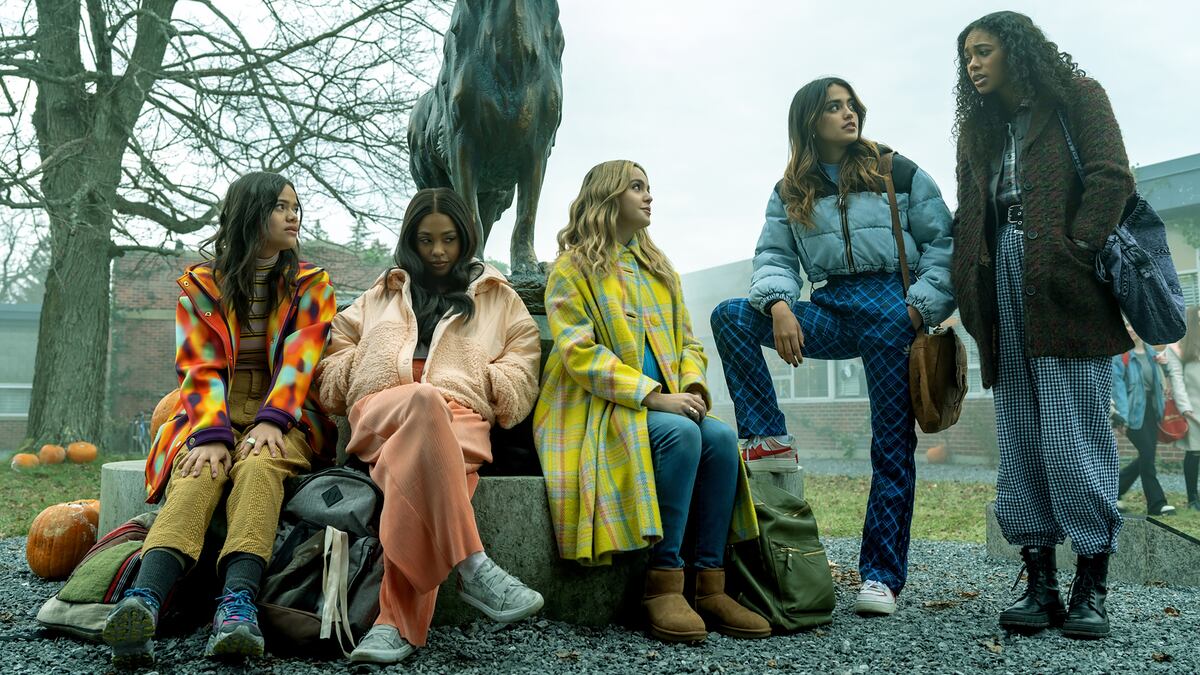One of the best TV scenes of the year almost didn’t happen. That’s right. We were almost deprived of the Pretty Little Liars: Original Sin scene in which Imogen (Bailee Madison) and Tabby (Chandler Kinney) road trip to Rosewood and let out all of their being-chased-by-a-masked-murderer teenage angst on the chorus of Alanis Morissette’s “Ironic” in the car. Haven’t we all been through enough?! Haven’t they?
We’re now three weeks and seven episodes into the first season of Pretty Little Liars: Original Sin, and so far, it has made good its initial promise to be the next great teen drama. Things have only gotten weirder for Imogen, Tabby, Noa, Faran, and Mouse since they banded together to take down their school’s bully, Karen, in the series premiere.
For starters, they’ve been dodging a masked killer known only as “A” for weeks, trying to piece together what all of their moms have to do with “A”’s presence while also dealing with the town sheriff breathing down their necks at every turn. And that’s not even taking into consideration the most daunting task of all: finding a cute Halloween costume!
We could write a short novela detailing all of the twists and turns that have happened in only seven hours of television. The body count keeps rising, Imogen’s due date is creeping closer, Mouse might be spinning down a To Catch a Predator rabbit hole, and there’s still a rapist at large. But if you’ve read this far, you’re probably already highly familiar with all of that.

That also means you know that, aside from Original Sin’s deliciously terrifying slasher storyline, the show has unfolded into something much more surprising than anyone would have expected the fourth entry into a teen drama franchise to be: genuinely emotionally compelling. The show’s integral balance of frights and friendship is crucial to its success so far; Original Sin doesn’t shy away from the realities of being a teenager, diving into sensitive topics with an astonishing amount of thought and care.
And that’s not just by chance. Original Sin’s creators Roberto Aguirre-Sacasa and Lindsay Calhoon Bring have intentionally designed it that way. Aguirre-Sacasa is no stranger to the teen soap—ever heard of a little show called Riverdale? He’s the mind behind its delightfully bonkers madness. He also helmed Netflix’s The Chilling Adventures of Sabrina, where Bring worked alongside him in the writers room. Together, the pair teamed up to create Pretty Little Liars: Original Sin as an unintentional perfect halfway point between Sabrina’s macabre impulses and Riverdale’s soapy delirium.
Ahead of the final three episodes of Original Sin, which drop Thursday on HBO Max, The Daily Beast spoke with Aguirre-Sacasa and Bring about their vision for a new set of Liars, how they developed the chilling new version of “A,” their fight to keep important moments from hitting the cutting room floor, and what’s in store for Millwood’s troubled teens in the shocking season finale.
I’m curious as to how the inception of this show came about. Roberto, I know you said that your bosses at Warner Bros. were looking for a new take on Pretty Little Liars, and even though the original had some horror aspects, it never really crossed over. What was the spark in your head that made you think, “Yeah, I want to do this as a slasher”?
Roberto Aguirre-Sacasa: Truthfully, it came out of Lindsay. When my bosses did approach me about doing a reboot—or, we’re not allowed to call it a reboot, reimagining—of Pretty Little Liars, I quickly realized that I should be doing this with a partner who could more authentically speak to the experiences of young teen girls, which felt like the heart of the franchise.
Lindsay Calhoon Bring: The Venn diagram of our loves meets in the middle with horror. I don’t know if I told this to Roberto, but I was very much a fan of his screenwriting. I knew that Roberto loved slashers, and I came to him with the idea of really leaning into horror but especially the subgenre of slasher. And of course, I think whether you’ve seen the original Pretty Little Liars or not, everyone is familiar with the concept of “A.” Everyone knows that “A” is the iconic villain, ever-changing. And so the idea was to make “A” the slasher villain, very much like a Michael Myers or a Jason Vorhees or a Freddy. The original show really flirted with horror, but I wouldn’t categorize it as a horror show. So we really wanted to honor the original by sharing some DNA and doing something a bit different.
One thing about iconic slasher villains is that they become so known for their appearances: Ghostface, Jason, and Freddy draw people in because people know and love that design. In the original Pretty Little Liars, “A” took on a lot of different forms and different costumes. If Original Sin returns for another season, do you think that you’ll keep the same iconic design for the killer, or might there be new iterations of “A” that we meet down the line?
RAS: That’s a really good question. Of course, we’re hopeful that Original Sin comes back for a second season. I would say we haven’t gotten too in the weeds about that. My instinct is that “A” would have a new design, though. I think. What do you think, Lindsay?
LCB: I…think so too? Roberto and I are obviously excited about new stories to hopefully tell in season two, but I think that a new design is good. One thing we have been open about is that you will know who “A” is at the end of this season, so I think that a new design comes with a new story and a new mystery.
We do have to give credit to our pilot director Lisa Soper, who directed half of the season. She actually designed the look of the mask.

It’s the perfect combination of Michael Myers and Leatherface.
RAS: I love “A”’s hair.
LCB: Me too! My husband last night was like, “Can I ask you something? What color is ‘A’’s hair?” I was like, “It’s like a…dirty blonde? Auburn?”
RAS: Orangey-brown?
Lindsay, I was so impressed by how often Original Sin takes time for friendly asides with the girls, where they’re allowed to connect and become closer with each other in ways that don’t necessarily propel the larger plot forward but strengthen the core relationships, which is such an essential part of the believability of an ensemble cast’s chemistry.
Scenes like Imogen and Tabby singing Alanis Morisette in the car together are so gratifying. Too often in teen dramas, it’s about repeatedly watching women in constant contention. Was it intentional to include these scenes, or did these come naturally as you wrote the show and got to know the actors better?
LCB: I think [it was] a mixture. One of the things that we wanted to keep alive that was so prevalent in the original series was the female friendships at the heart of it. The way our show differs is that, in the original show, the girls had been friends—they already had a whole history. We had to create brand new friendships with girls who didn’t really know each other, so I think those moments are very important. At that age, you can really become best friends and family quickly and over the simplest things.
I love [the Alanis scene]. We talked about that moment a lot. That’s our road trip episode and we really wanted to have a moment of the girls in the car. It’s a heavy episode, Tabby and Imogen really unpack their traumas together. I think Roberto mentioned this early on as the sort of Thelma and Louise episode. And I think that, through trauma, you do have to find the light and the joy in your friendships too.
It’s one of those things that you can throw in there and it would be just as easy to take it out—
RAS: —By the way, they tried to take it out! They tried to take it out! They infamously said, “We know you want the scene in the car but do we need the scene in the car.” Those moments were really hard-fought. It was even very early on, I remember when we were talking with our executives, and at one point, one of [them] said, “Once you get to episode three, the girls stop having fun.” And we’re like, “What do you mean?” And they’re like, “Well, yeah, the killer’s after them, they’re not going to be joking around and doing fun teen stuff.” And we were like no, no, that continues until the end! So there was some tension about how much is just the mystery and how much is just the threat of “A” versus balancing the normal teen friendships and romance. Those things were hard-fought.
There are a lot of sensitive subjects discussed in the show: teenage pregnancy, sexual assault, self-harm, addiction—and they’re not just plot devices that are brought up and thrown away, but things that are worked through. What made you both want to incorporate those very real things into this series?
LCB: We were developing the show and knew this was a horror show but knew that this centered on a coming-of-age story about young women. As much as there’s a slasher villain named “A” with a crazy mask and orange hair, we wanted to tell a grounded story about the real horrors that young women go through. That I’d gone through and that many of the women in our writers room had gone through, and directors and cast. And it’s hard to shy away from sexual assault and grooming and rape in those stories.
I think I had brought to Roberto that both Tabby and Imogen had faced the same trauma and were connecting over this. And upsettingly, depressingly, and statistically, that is a real possibility—that you and someone in your friend group would both be attacked. You don’t always, as a young person, have the language for things that are happening to you, but you can point to characters in books, TV shows, and movies. It was important for both of us to be able to create something really moving for young people to be able to point to and say, “Maybe I don’t understand this, or what happened to me or happened to a friend, but I can point to these characters and look to them and understand it a bit better.”
And something I like about the show is that, while it’s obviously discussing all of these really important things, and doing so with care, it doesn’t feel sanitized. These teens are awful to each other, and—at least for me—part of the fun is seeing how evil teenagers can be to one another, but then watching them get their comeuppance.
LCB: I think Roberto and I also bond over loving unlikeable characters. I think it’s great to have unlikeable teen characters on TV!
RAS: We both immediately notice when there’s a show that’s so clearly pulling its punches because it doesn’t want to make any of the characters unlikeable or problematic or messy. We thought that that was just not real. Horror is a genre of extremes. Imagine the mean girls in Carrie apologizing to Carrie—there’d be no Carrie!
Keep obsessing! Follow the Daily Beast’s Obsessed on Facebook, Twitter, Instagram and TikTok.






